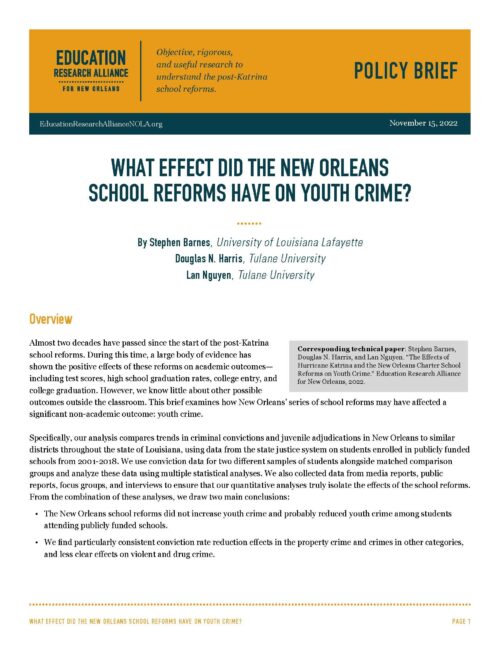What Effect Did the New Orleans School Reforms Have on Youth Crime?
A new study from Stephen Barnes, Douglas N. Harris, and Lan Nguyen examines how the post-Katrina school reforms affected youth conviction rates.

What Effect Did the New Orleans School Reforms Have on Youth Crime?
Published
by Stephen Barnes, Douglas N. Harris, Lan Nguyen
Almost two decades have passed since the start of the post-Katrina school reforms. During this time, a large body of evidence has shown the positive effects of these reforms on academic outcomes — including test scores, high school graduation rates, college entry, and college graduation. However, we know little about other possible outcomes outside the classroom. This brief examines how New Orleans’ series of school reforms may have affected a significant non-academic outcome: youth crime. Specifically, our analysis compares trends in criminal convictions and juvenile adjudications in New Orleans to similar districts throughout the state of Louisiana, using data from the state justice system on students enrolled in publicly funded schools from 2001 – 2018. We use conviction data for two different samples of students alongside matched comparison groups and analyze these data using multiple statistical analyses. We also collected data from media reports, public reports, focus groups, and interviews to ensure that our quantitative analyses truly isolate the effects of the school reforms. From the combination of these analyses, we draw two main conclusions: The New Orleans school reforms did not increase youth crime and probably reduced youth crime among students attending publicly funded schools. We find particularly consistent conviction rate reduction effects in the property crime and crimes in other categories, and less clear effects on violent and drug crime. We say that the reforms “probably” reduced youth crime due to factors that make this kind of analysis complex. First, our data only allow us to observe crimes that resulted in adjudications or convictions — a common problem in studies of crime. Second, we had to separate the effect of the reforms from other factors affecting crime in the wake of Hurricane Katrina. We addressed these problems by comparing youth adjudications and convictions to those of adults. To further address possible differences between convictions and crime itself, we also interviewed community leaders with expertise in the criminal justice system. While our analyses generally suggest that the changes in convictions and adjudications reflect changes in crime due to the school reforms, the complexities involved in this type of analysis lead us to be somewhat cautious in our conclusions. Despite some uncertainty about the effects, this analysis is important because it helps to get beyond common metrics like test scores to understand schools’ wide-ranging effects on students and their communities.
Related Publications
Climbing the College Ladder? The Effects of the New Orleans School Reforms on the Quality and Fit of Colleges That Students Attended
Dec 15, 2020 | by Beth Glenn, Douglas N. Harris
White and Higher Income Students are More Likely to Benefit From OneApp’s Half-mile Admissions Priority
Dec 8, 2020 | by Alica Gerry, Cathy Balfe, Lindsay Bell Weixler
Do Students Perceive Their Teachers and Schools More Positively When More of Their Teachers Look Like Them?
Sep 23, 2020 | by Alica Gerry, Lindsay Bell Weixler

